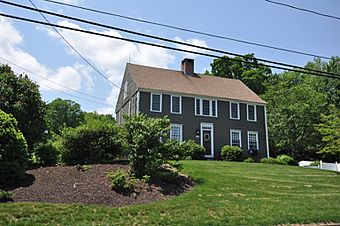Rev. John Wightman House facts for kids
Quick facts for kids |
|
|
Rev. John Wightman House
|
|
 |
|
| Location | 1024 Mount Vernon Rd., Southington, Connecticut |
|---|---|
| Area | 3 acres (1.2 ha) |
| Built | 1770 |
| Architectural style | Colonial, New England Colonial |
| MPS | Colonial Houses of Southington TR |
| NRHP reference No. | 88003111 |
| Added to NRHP | January 19, 1989 |
The Rev. John Wightman House is a very old house located at 1024 Mount Vernon Road in Southington, Connecticut. It was built around 1770 for the town's second Baptist minister, John Wightman. This house is a great example of Georgian architecture from that time. It was added to the National Register of Historic Places in 1989 because of its historical importance.
Contents
What Does the House Look Like?
The Rev. John Wightman House is a two-and-a-half-story building made of wood. It has a pointed roof and a chimney in the middle. The outside is covered with overlapping wooden boards called clapboards.
Front of the House
The front of the house has five sections, with windows placed evenly around a door in the center. The windows on the top floor are very close to the roof line. They have a small, decorative trim called dentil moulding, which looks like small blocks. The windows and the main entrance on the ground floor have slightly sticking-out tops.
Special Features
The main door has narrow decorative trim on its sides. Above the door, there is a special window called a transom window. It has five small glass panes shaped like a tombstone. Right above this, there is a three-part window with two narrow side windows. The inside of the house also has interesting old designs. There is an addition at the back of the house that was built later.
Who Was John Wightman?
John Wightman was a Baptist minister who traveled a lot. He bought the land for this house in 1770. People believe he had the house built soon after he bought the land. He became the second official minister for a small group of Baptist families in the area.
His Legacy
John Wightman is buried in a small cemetery not far from the house. His son, Valentine, became the minister after him. Valentine's own house was located further north on Mount Vernon Road.



